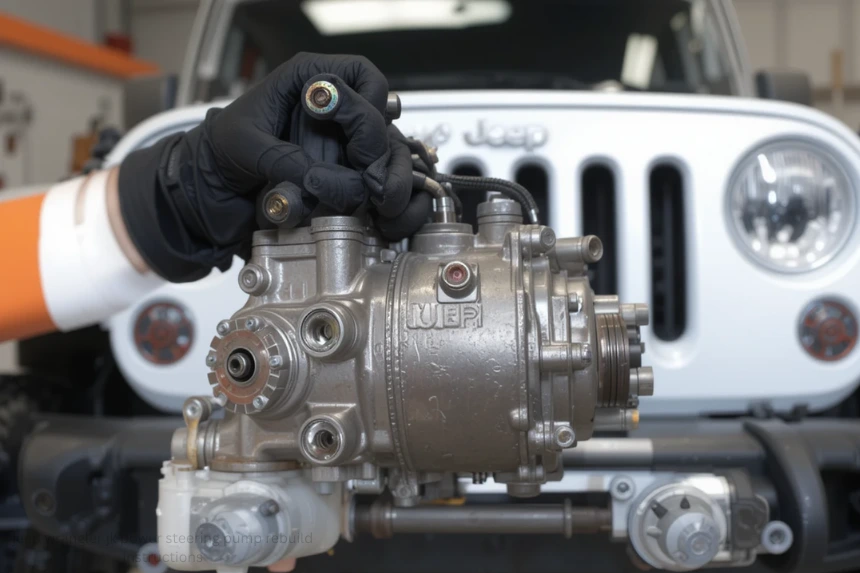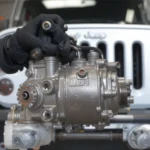Rebuilding your Jeep Wrangler JK power steering pump can save you money and extend the lifespan of your vehicle’s steering system. Whether you’re an experienced mechanic or a weekend DIY enthusiast, knowing the proper procedure to rebuild your power steering pump ensures that your Jeep remains reliable and safe on the road. This guide provides detailed, easy-to-follow instructions on how to rebuild your Jeep Wrangler JK power steering pump, covering all necessary tools, safety precautions, and tips for success.
Understanding Your Jeep Wrangler JK Power Steering Pump
The power steering pump in your Jeep Wrangler JK is a crucial component that assists in steering by providing hydraulic pressure to the steering system. Over time, the pump can develop issues such as leaks, whining noises, or reduced steering power. Rebuilding the pump involves disassembling, inspecting, replacing worn parts, and reassembling it to restore optimal performance.
Before starting the rebuild process, it’s essential to understand the common signs indicating your power steering pump needs repair:
- Whining noise when turning
- Difficulty steering or stiff steering
- Leaking fluid around the pump
- Reduced steering responsiveness
Tools and Materials Needed
It goes more smoothly if the appropriate equipment and supplies are gathered in advance:
- Socket set and ratchets
- Pulley removal tool (if necessary)
- Screwdrivers (flat-head and Phillips)
- Power steering pulley puller (if applicable)
- Replacement seals and O-rings
- Power steering fluid
- Clean rags or towels
- Drain pan
- Safety gloves and eye protection
Step-by-Step Instructions for Jeep Wrangler JK Power Steering Pump Rebuild
1. Safety First: Prepare Your Workspace
Make sure your vehicle is parked on a level surface and that the parking brake is engaged. In order to avoid any electrical accidents, disconnect the negative battery terminal. Wear safety gloves and eye protection throughout the process.
2. Drain Power Steering Fluid
Locate the power steering pump, typically mounted on the engine block. Use a drain basin to catch the fluid as you disconnect the hoses. Carefully remove the high-pressure and return hoses from the pump, allowing the fluid to drain completely. Wipe the surrounding area clean to prevent contamination.
3. Remove the Power Steering Pump
Using a socket set, loosen the bolts securing the power steering pump to the bracket. Depending on your Jeep’s configuration, you might need to remove or loosen the serpentine belt to access the pump pulley. Remove the pulley using a pulley removal tool, if necessary. Carefully detach the pump from the mounting bracket.
4. Disassemble the Pump
Place the pump on a clean work surface. Remove the pulley, then carefully disassemble the pump by removing the cover and enough internal components to access the worn parts. Take note of the order and orientation of parts for reassembly. Use clean rags to keep parts free from dirt and debris.
5. Inspect Components and Replace Worn Parts
Examine inner components such as the gears, seals, and O-rings for wear, cracks, or damage. Replace all worn or damaged seals and O-rings with new parts. If the hydraulic gears or other internal components show significant wear, consider replacing the entire pump or sourcing high-quality rebuild kits.
6. Clean the Pump Body
Thoroughly clean the pump housing and internal components using a suitable solvent. Ensure all dirt, debris, and old lubricant are removed to prevent contamination during reassembly.
7. Reassemble the Pump
Carefully reattach internal components in the correct order and orientation. Install new seals and O-rings using a small amount of power steering fluid or O-ring lubricant to facilitate installation and ensure a proper seal. Replace the cover and secure it tightly.
8. Reinstall the Pump
Mount the rebuilt power steering pump back onto its bracket in the engine bay. Tighten the mounting bolts securely. Reinstall the pulley using the pulley removal tool if you had removed it earlier. Reconnect the power steering hoses, ensuring they are tight and free of damage.
9. Refill and Bleed the Power Steering System
Replenish the system with fresh power steering fluid. To remove air from the system, start the engine and repeatedly turn the steering wheel from lock to lock. Check for leaks and top off fluid as needed. Ensure the fluid level remains within the recommended range.
10. Final Checks and Test Drive
Inspect all connections and fittings for leaks. Reinstall the serpentine belt if it was removed. Start the vehicle, and test drive your Jeep Wrangler JK to ensure smooth steering and quiet operation. Make any necessary adjustments, and periodically check fluid levels and for leaks over the next few days.
Tips for a Successful Power Steering Pump Rebuild
- Always use high-quality replacement seals and O-rings tailored for Jeep models to ensure longevity.
- During disassembly, keep track of all the screws and tiny components.
- Take photos during disassembly to help during reassembly.
- Work in an area with adequate ventilation and wear safety gear.
- If you’re unsure about any step, consult with a professional mechanic or refer to the vehicle’s service manual.
Final Thoughts
Rebuilding your Jeep Wrangler JK power steering pump is a rewarding and cost-effective way to maintain your vehicle’s steering system. With patience, proper tools, and careful attention to detail, you can successfully restore your pump’s performance and extend its service life. Regular maintenance and timely repairs will keep your Jeep running smoothly and ensuring safety on all your adventures.



